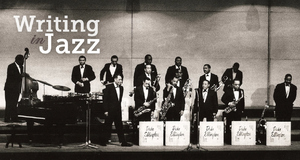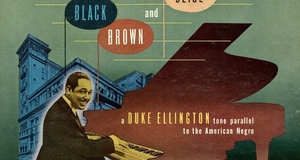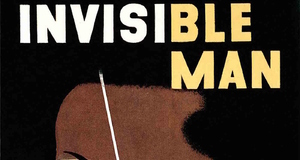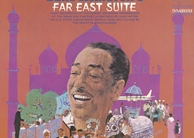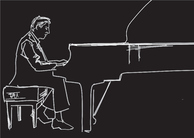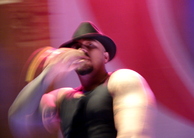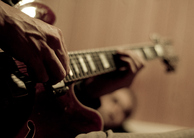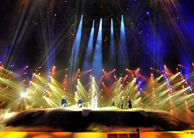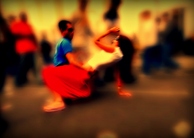"Jazz Is My Story:" A Historical Analysis of Jazz and 20th Century African-American Literature
By
2017, Vol. 9 No. 11 | pg. 1/1
IN THIS ARTICLE
KEYWORDS
The period of time from the Bebop era to the present—mid-1940s onwards—has been an era of great cultural evolution in the United States, and in few groups more so than the African American community. A factor particularly significant in this journey, and one with which jazz music has been closely tied over the past century, is African American literature. This genre, more colloquially called black literature, has only been a formal notion since the Harlem Renaissance (from roughly 1919 to 1939), during which prominent black leaders sought to elevate black culture and status by producing art, leading political movements, and advancing the fight for civil rights. Though jazz music had already taken root in American culture as an influential music style, it was minimally referenced in black literature during this era. By the time jazz music had transitioned from being music for dancing to “art music” for listening after World War II, the influence of jazz in written works had greatly increased. Jazz poems like “Jazz is My Religion” by Ted Joans tended to be direct and specific in their references to jazz, citing specific artists as well as justification for the style’s personal and cultural significance. Other literary expressions of jazz, for instance jazz novels such as Invisible Man by Ralph Ellison and improvisational Beat poetry, were more subtle in their relation to jazz, but the allusions and direct influence drawn from the music manifested themselves in a variety of ways, each uniquely illustrating the extent to which jazz music was a cultural driving factor in the post-bebop era. The Black Arts Movement (also known as the Black Aesthetic Movement) in the 1960s was one of the strongest catalysts spurring creation of literary works tied to jazz. Though the Harlem-born movement was focused on art, the associated black poets, musicians, and writers were motivated by political ties to the Black Power movement. Simultaneously, individuals unaffiliated with the Black Arts Movement also contributed to the growing collection of jazz-related literary works, for instance Michael S. Harper, whose poetry features dozens of influential jazz musicians.As jazz has evolved over time, the demographic profile of its audience has shifted accordingly. In modern-day America, jazz music lacks the widespread popularity and strong appeal to younger generations it once held. However, this has not stopped the ongoing efforts of novelists and poets such as Yusef Komunyakaa to create compelling new literary works referencing historic figures, performances, and characteristics of jazz. The following discussion will more closely examine the relationship between jazz music and African American literature during the four time periods introduced above: the Harlem Renaissance (1919-1939), post-World War II (mid-1940s to 1950s), the 1960s to 1970s, and the 1980s to present. Jazz music has never existed in isolation: it has always impacted and been impacted by the cultural climate and other art forms. It is difficult to enumerate every particular connection jazz has to other aspects of society, but summarized succinctly, “In all of its modes, jazz narrates a people’s emotional reaction to oppression, expresses the artistic abilities of African-Americans, and provides a voice for those whose voices have been beaten into submission” (Theriault, 1).These are broad themes, all of which extend well beyond jazz music in their influence. If one is to attempt to understand jazz music at any level, the cultural context is critical background that cannot be ignored. Literature is a particularly powerful avenue through which to analyze these themes in jazz music, as the work of writers and poets is often motivated by similar societal factors as musicians. The overarching idea of art as a means of expression and communication is one that has transcended both time and art medium, and certainly extends into jazz music and African American literature as well. Black Literary Roots Originate During the Harlem Renaissance.The Harlem Renaissance was a key period for the development of a new African American identity in the United States, and was as much about art as it was about political movements and civil rights. Jazz music was a significant part of mainstream American culture during the “Roaring 20s” (also called the “Jazz Age”), emblematic of the fast speed of life and post-war energy following the end of World War I in 1918 (M. Harvey, “Midwestern Jazz—Bix Beiderbecke & The European Fascination” lecture, October 6, 2016). For this reason, it is somewhat surprising that jazz music was minimally referenced in black literature during this time. Michael Borshuk, author of Swinging the Vernacular: Jazz and African American Modernist Literature, attributes the unpopularity of jazz music during the Renaissance, especially in the period’s literature, to two distinct attitudes amongst white and black critics:
This exclusion of jazz from the Renaissance, Borshuk further explains, can be attributed to a variety of factors including increased class consciousness among African Americans in the 1920s and desire to distance the revitalized culture from long-standing stereotypes. Perhaps to even a greater extent, the underrepresentation of jazz in Renaissance works may be consequence of a heightened cultural focus on European art, which came at the cost of appreciation of the African American musical tradition (Borshuk, 22-23). A notable exception to Renaissance figures keeping their distance from jazz music was 20 th century writer Langston Hughes, informally lauded as the Father of Jazz Poetry: initially for his collection The Weary Blues (1926), the first poetry focused on jazz music and the blues, but more so for his career-long focus on writing poems in the blues form and others that drew deeply upon jazz and blues thematically. Equally innovative among Hughes’ contributions were his later experimentation with reading poetry to jazz music and his including musical annotations typical of jazz music in the margins of his writings, as was the case in Ask Your Mama (1961), a book dedicated to Louis Armstrong (Feinstein, 44). In stark contrast to other Renaissance figures’ disdain for jazz music, Hughes viewed jazz music as in line with Renaissance goals for all of its qualities, which he perceived as transformative in their own right:
Outside the context of the Harlem Renaissance, other writers in the United States—white modernists in particular— during the 1920s caught wind of the significance of jazz music to national culture. This influence manifested itself in modernist poems both through specific descriptions of jazz performances and in less direct, stylistic aspects. As contended by poet Mina Loy in her 1925 essay “Modern Poetry,” jazz reflected “the collective spirit of the modern world.” Given the general context of contemporary poetry in the United States, Hughes’s works seem less isolated in their focus on jazz when viewed outside of a characterization solely within the African American tradition. Jazz Poetry and Jazz Novels Gain Prominence After World War IIThe end of World War II in 1945 marked tremendous change for the entire country. Jazz music was not exempt: as a consequence of war-related challenges, internal music industry struggles, and a transition to smaller performance venues, the end of World War II coincided with the end of the Swing Era and the start of a transition from jazz as dance music instead to “art music” for listening. Simultaneously, the influence of jazz in other art forms—particularly written works— increased. Ted Joans’ jazz poem, “Jazz is My Religion,” is a key example from this time period. Jazz poetry is a loosely defined term, one on which Feinstein elaborated on in A Bibliographic Guide to Jazz Poetry (Feinstein, Introduction):
Partly due to this amorphous definition of jazz poetry, it is difficult to compile an exhaustive list of works from this era. “Jazz is My Religion,” however, is a clear example of poetry with literal references to jazz music— Joans cites specific artists and the style’s personal and cultural significance. The second half of the second stanza of “Jazz is My Religion” is particularly illustrative of this:
Joans speaks of jazz artists reverently, with a sense of closeness and devotion characteristic to many of his famous works. Though Joans was particularly fixated on Charlie Parker (the musician most often featured in his writing), another one of his poems, “Jazz Must Be a Woman,” lists more names of jazz musicians than any other published poem— an appropriate distinction for a writer as focused on jazz as Joans was. No discussion of jazz-related literature from this era would be complete without inclusion of Ralph Ellison’s Invisible Man (1952), winner of the National Book Award and lauded as one of the most successful jazz novels ever penned. Invisible Man demonstrates a style of jazz literature quite unlike the direct references to jazz found in “Jazz is My Religion,” instead replete with allusions and more subtle examples of the music style’s influence. Ellison’s novel has been compared to Langston Hughes’ poetry for its stylistic innovation and Hughes’ prowess at “emphasizing musical sound as a meaningful signifier of black identity, and perhaps more importantly, further investigating the possibilities of bebop’s ‘politics of style’.” (Borshuk, 91). Of all the jazz music subtypes to which jazz literature can be likened, bebop is perhaps the most complex source of inspiration. Bebop, a jazz style characterized by its complex harmonies and chord changes, rapid rhythm, and virtuosic display of harmonic and melodic creativity, burst into the musical scene in 1945 (M. Harvey, “Bebop—The First Revolution, Diz, Bird & Afro-Cuban Music” lecture, November 1, 2016). One aspect of bebop’s experimental nature was a frequent repurposing of old tunes with new harmony, as heard in the bebop classic “Shaw Nuff” performed by Charlie Parker and Dizzy Gillespie. The piece features a new melody based on the Gershwin classic “I Got Rhythm,” which in the Collectible Records edition is quintessentially bebop-like with modified chords and an impossibly quick pace (Gillespie, “Shaw Nuff”). Unlike the largely predictable percussive style of Swing Era rhythm sections, the drummer’s sporadic interjections (“dropping bombs”) and pianist’s comping heighten the rhythmic complexity of the piece. Coupled with its dissonances, virtuosic solos, and the overall energy of the piece, “Shaw Nuff” contains essentially all of the key characteristics of the bebop style. Those who have analyzed the thematic content in Invisible Man recognize a number of ways in which the complex design of the novel parallels characteristics of bebop compositions like “Shaw Nuff.” A general sense of uneasiness is pervasive in Ellison’s writing, both in the narrator’s descriptions of certain African American performances and of black characters throughout the novel, as the narrative straddles complex social issues involving artistic expression and what it means to be African American. A more subtle jazz-like characteristic of Invisible Man is its experimental structure and the narrator’s emphasis on freedom and self-expression (Borshuk, 107-111). Such a thoughtful combination of stylistic elements drawn from jazz music is a reflection of Ellison’s uniquely informed academic background in music, which lent him a technical knowledge and an understanding of black music for more than just its superficial qualities. Following from this personal connection, it comes as little surprise that Ellison’s landmark novel explores the centrality of music in culture and in the development of self-identity. Improvisational Beat poetry, a style of writing vastly different from the styles examined above, was also influenced by jazz music during this time period. Bob Kaufman, a poet known for his improvised poetry performances (the words to which were rarely penned), drew a significant influence from alto saxophonist Charlie Parker. Kaufman’s poetry is characterized by its pieced-together imagery, a literary imagination of the collage of sounds made by a jazz ensemble. One of Kaufman’s most famous poems, “Crootey Songo,” is reminiscent of scatting, as would have been heard in performances by vocalists including Ella Fitzgerald, one of the masters of scat singing post-Swing Era (M. Harvey, “End of an Era—Stars, Small Groups” lecture, October 25, 2016). With lines such as the opening “Derrat slegelations, flo goof baber,” Kaufman constructs an evocative string of syllables that suggests a meaning, or at least a level of higher-level organization than random syllables—not unlike a soloist’s improvisation in a jazz piece. New Works and Youth Engagement Peak During the Black Arts MovementFollowing the momentum built during the preceding decades, the 1960s were as much a time when diverse works of literature were created in homage to jazz. The Black Arts Movement, a pivotal point in the development of African American culture in the United States, was an opportunity for many young black writers to emerge on the literary scene. Among these were poets who often drew upon jazz music for influence in manners similar to their literary predecessors: writing poems specifically for particular jazz artists or imitating musical qualities of jazz from its shape to its flow or a particular combination of instruments. Arguably as important as the literary works created during this time period is the significance of the younger population’s engagement with jazz at the time— for its association with a larger artistic and intellectual movement, jazz music was enticing and important to young adults in a way it has not felt in recent decades. One individual key in introducing younger Americans to jazz music through his writing was Amiri Baraka, whose famous works include a collection of essays entitled Black Music, which focused on experimental jazz. Highlighting the influence of the Black Arts Movement is not to say unaffiliated artists were unimportant during the 1960s and 1970s— for instance, poet Michael S. Harper remains one of the best-read jazz writers even today. Commenting on Harper’s influence, Feinstein wrote: “Harper became the dominant jazz poet of the 1970s, and Dear John, Dear Coltrane remains one of the most engaging books of poetry with a thematic emphasis on jazz… his overall importance in the history of jazz poetry cannot be overstated.” (Feinstein, 39). “Dear John, Dear Coltrane,” the poem, illustrates Harper’s fascination with John Coltrane and includes repetition of the refrain “a love supreme, a love supreme”—a line from Coltrane’s 1965 landmark album of the same name. In this poem, Harper ties Coltrane’s life history closely to the development of jazz in 20 th century urban life, an indication of Coltrane’s centrality during this time period. Such is observed in lines 19-24 of the poem (Harper, 25):
Harper’s poetry is influential both in its lyrical style, and in that it builds upon African American literature from earlier days: in particular, that of Langston Hughes and Ralph Ellison discussed above. As summarized by Borshuk, “Harper’s poetry fuses his predecessor’s signal developments—Ellison’s dialogic narration of history, Hughes’s stylistic play—and argues for jazz music’s enduring essential place in American culture.” (Borshuk, 121). Yet another parallel to jazz music emerges here: Harper borrowing from older writers’ toolkits is strongly reminiscent of jazz musicians adopting their stylistic qualities of their musical predecessors. Modern Jazz Writing Continues to Draw InfluenceThough the presence of jazz in the modern musical landscape has continued to decline, even today there are black writers who continue to incorporate jazz music into literary works. Pulitzer Prize winner Yusef Komunyakaa, known for his original jazz poems and his work on The Jazz Poetry Anthology (1991) and The Second Set: The Jazz Poetry Anthology (1996), is considered one of the key figures in modern jazz writing. The wide array of jazz musicians referenced in his works—from Charles Mingus in Copacetic to Mary Lou Williams in “My Father’s Love Letters” (Magic City) and Duke Ellington in “Twilight Seduction” (The Second Set) (Feinstein, 53)—is illustrative of these figures’ enduring importance in American history despite the declining popularity of jazz music from the 1980s to present day. The relationship between jazz music and African American literature has not been static over the past century, but each example of interaction between the two is an illustration of the close ties jazz music has held to the cultural climate and societal landscape—both in the past and present. Analyzing the relationship between post-bebop jazz music and African American literature, and drawing comparisons between two fundamentally different art forms, demands an analysis beyond the superficial characteristics of each in order to identify the larger-scale similarities. Though the historical context and popularity of jazz music evolved over the four time periods explored above, the literary works referenced draw upon jazz music in similar ways: either directly describing or quoting it, or incorporating its qualities into the structure or style of the writing. Both approaches are equally impactful in the writing— as much a credit to the authors as it is to jazz music being a dynamic topic to write about. Analyzing jazz music through the lens of African American music lends a stronger understanding of the cultural context that surrounded art in the 20 th century African American community. Such an analysis motivates an appreciation for how fundamentally transformative jazz music has been in shaping aspects of American culture. A study of the relationship between jazz music and visual art would likely reveal similarly connected works, as most any medium of art has the capacity to evocatively express a concept or emotion. While jazz is not mainstream popular music in America today, its enduring representation in African American literature is a direct manifestation of its timeless quality and vast cultural significance. ReferencesBorshuk, M. (2006). Swinging the Vernacular: Jazz and African American Modernist Literature. New York: Routledge. Feinstein, S. (1998). A Bibliographic Guide to Jazz Poetry. Westport, CT: Greenwood Press. [Recorded by D. Gillespie]. (2006).Shaw Nuff[CD]. Collectables Records. Harper, M. S. (2000). Songlines in Michaeltree: New and Collected Poems. Urbana: University of Illinois Press. Theriault, S. A. (2011). "Jazz Writing: Identity and Multiculturalism in Jazz Literature."Inquiries Journal. 3(06). Retrieved from http://www.inquiriesjournal.com/articles/542/jazz-writing-identity-and-multiculturalism-in-jazz-literature. Suggested Reading from Inquiries Journal
Inquiries Journal provides undergraduate and graduate students around the world a platform for the wide dissemination of academic work over a range of core disciplines. Representing the work of students from hundreds of institutions around the globe, Inquiries Journal's large database of academic articles is completely free. Learn more | Blog | Submit Latest in Music |








